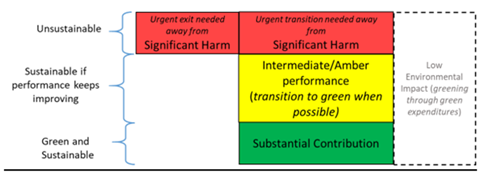Jan Vandermosten, Senior Policy Analyst, EU, PRI

If recent wildfires and heatwaves across Europe make you worry about how climate change, droughts and the destruction of ecosystems may affect your financial performance, there is still hope. The Platform on Sustainable Finance (PSF), which advises the European Commission on the EU taxonomy and sustainable finance, has designed a new approach for greening portfolios.
Consider this. The PSF recently published a report that provides a very promising way to easily identify how investments are contributing to a transition to a net-zero and resource-efficient society that’s friendly to nature. We believe that translating this proposal into law would be of benefit to investors – whether the European Commission will do so will become clear once, as expected, it presents its views.
The current EU taxonomy rules for sustainable finance aim to identify which economic activities can be labelled sustainable. They are based on six environmental objectives: climate change mitigation, climate change adaptation, biodiversity, pollution, water and circular economy. To be recognised as “taxonomy-aligned”, an economic activity must meet three conditions:
- make a substantial contribution to at least one of the six environmental objectives;
- do no significant harm to any of the other objectives;
- meet minimum social safeguards such as international human and labour rights.
Specific thresholds are adopted in subsequent legislation to define exactly what “significant contribution” and “do no significant harm” mean for each economic activity covered by the EU taxonomy. For example, for energy activities, the regulatory thresholds are expressed as the amount of CO2 emissions per unit of power produced.
The current rules apply to sustainable economic activities, indicated by the green box in Figure 1. While the rules are designed to green portfolios and the investments they contain, they do not sufficiently respond to the increasing imperative for investors: spotting how firms are positioned for shifting their overall business from harmful to sustainable.
Figure 1: Types of economic activities by their environmental impact. Source: The Extended Environmental Taxonomy

The extended measures proposed by the PSF meet this need by adding new categories that cover a much larger share of the economy, notably:
- A category of activities that cause significant harm to the environment, shown in red in Figure 1. These can be further divided between activities that can improve their sustainability performance and those that cannot change – such as power generation from coal – and should therefore be decommissioned.
- A category of activities that sit between those causing significant harm to the environment and those making a substantial contribution to the environmental objectives. These are shown in amber in Figure 1 and include steel manufacturing, forestry and building renovation among other things. These activities need to continually improve their performance to become green and, therefore, make a substantial contribution to the environmental objectives under the rules.
The framework can already be tested. The PSF recommends using existing regulatory thresholds in the EU taxonomy to determine whether an activity falls into one of the two new categories.
An extended environmental taxonomy would also be complementary to other frameworks that support investors in navigating the transition. They include guidance on investor transition plans from the Glasgow Financial Alliance for Net Zero or Investor Climate Action Plans from the Investor Agenda. These initiatives place a lot of emphasis on ensuring investors engage with companies to compel them to adopt credible net-zero transition plans across all their activities.
An extended environmental taxonomy would allow investors to gauge the environmental performance of every business unit. The approach can also indicate to what extent companies are allocating capital to make their activities more sustainable or phasing them out in case they cannot improve their environmental performance.
Navigating the environmental transition is becoming increasingly critical to investors. An environmental taxonomy that covers economic activities with varying degrees of environmental impact would be a very powerful tool in guiding investors’ engagement strategies and capital allocation decisions. At the PRI, we are planning further work on the basis of the framework presented by the PSF, including testing it with our signatories. If you want to be part of this journey, please feel free to reach out to [email protected].
This blog is written by PRI staff members and guest contributors. Our goal is to contribute to the broader debate around topical issues and to help showcase some of our research and other work that we undertake in support of our signatories. Please note that although you can expect to find some posts here that broadly accord with the PRI’s official views, the blog authors write in their individual capacity and there is no “house view”. Nor do the views and opinions expressed on this blog constitute financial or other professional advice. If you have any questions, please contact us at [email protected].












